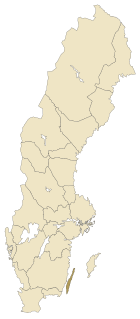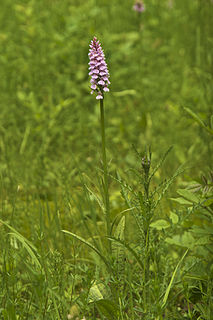
Högsby Municipality is a municipality in Kalmar County, south-eastern Sweden. Its seat is located in the town Högsby.

The House of Vasa was an early modern royal house founded in 1523 in Sweden, ruling Sweden 1523–1654, the Polish-Lithuanian Commonwealth 1587–1668, and the Tsardom of Russia 1610–1613. Its agnatic line became extinct with the death of King John II Casimir of Poland in 1672.

Södermanland, sometimes referred to under its Latin form Sudermannia or Sudermania, is a historical province or landskap on the south eastern coast of Sweden. It borders Östergötland, Närke, Västmanland and Uppland. It is also bounded by lake Mälaren and the Baltic Sea.

Hälsingland, sometimes referred to as Helsingia in English, is a historical province or landskap in central Sweden. It borders Gästrikland, Dalarna, Härjedalen, Medelpad and the Gulf of Bothnia. It is part of the land of Norrland.

The Early Vasa era is a period that in Swedish and Finnish history lasted between 1523–1611. It began with the reconquest of Stockholm by Gustav Vasa and his men from the Danes in 1523, Which was triggered by the event known as the Stockholm Bloodbath in 1520, and then was followed up by Sweden's secession from the Kalmar Union, and continued with the reign of Gustav's sons Eric XIV, John III, John's son Sigismund, and finally Gustav's youngest son Charles IX. The era was followed by a period commonly referred to as the Swedish Empire, or Stormaktstiden in Swedish, which means “Era Of Great Power”.

An alvar is a biological environment based on a limestone plain with thin or no soil and, as a result, sparse grassland vegetation. Often flooded in the spring, and affected by drought in midsummer, alvars support a distinctive group of prairie-like plants. Most alvars occur either in northern Europe or around the Great Lakes in North America. This stressed habitat supports a community of rare plants and animals, including species more commonly found on prairie grasslands. Lichen and mosses are common species. Trees and bushes are absent or severely stunted.
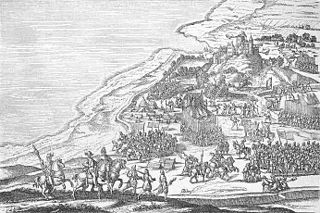
The Northern Seven Years' War was fought between the Kingdom of Sweden and a coalition of Denmark–Norway, Lübeck and Poland between 1563 and 1570. The war was motivated by the dissatisfaction of King Frederick II of Denmark with the dissolution of the Kalmar Union, and the will of King Eric XIV of Sweden to break Denmark's dominating position. The fighting continued until both armies had been exhausted, and many men died. The resulting Treaty of Stettin was a stalemate, with neither party gaining any new territory.

A bird reserve is a wildlife refuge designed to protect bird species. Like other wildlife refuges, the main goal of a reserve is to prevent species from becoming endangered or extinct. Typically, bird species in a reserve are protected from hunting and habitat destruction. Because of the protection they provide from such threats, bird reserves also serve as excellent locations for bird watching. Normally, wildlife refuges are under the care of non-profit organizations and governmental institutions.

Strömsholm Palace, sometimes called Strömsholm Castle, is a Swedish royal palace. The baroque palace is built on the site of a fortress from the 1550s, located on an island in the Kolbäcksån river at the west end of Lake Mälaren. The palace has interiors from the 18th century and an important collection of Swedish paintings.

Halltorp is one of the earliest manor houses on the island of Öland, Sweden, dating from the 11th century AD. In early documents it is known as Hauldtorp, and it is cited as one of the early Viking settlements of Öland. In earlier times it has functioned as a royal farm associated with the Swedish Crown and was considered one of the finest hunting preserves on the island. There is a relict oak forest on the present grounds which contains numerous trees that are centuries old. Halltorp is in an area rich in history and biodiversity, and most of the island of Öland has been designated as a World Heritage Site. The site is adjacent to the perimeter highway, Route 136.
Ottenby is a town on the island of Öland, Sweden, located in Ås parish, Mörbylånga Municipality in Kalmar County. Ottenby is located just north of the southern tip of Öland, over three miles south of the area's main town, Mörbylånga. Ottenby is also the name of the mansion and a royal demesne, now a nature reserve.
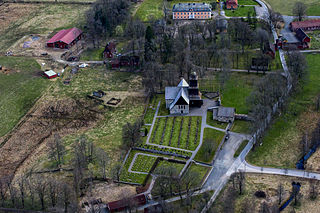
Nydala Abbey was a Cistercian monastery in the province of Småland, Sweden, near the lake Rusken. Although the abbey ceased to operate in the 16th century, its church was renovated and converted into a Protestant church during the 17th century and is still in use. The church belongs to the Church of Sweden and is part of the Diocese of Växjö.

Örbyhus Castle is a castle in Tierp Municipality, Sweden. It lies some 12 kilometres east of European route E4, approximately halfway between Uppsala and Gävle.

Vårfruberga Abbey, previously Fogdö Abbey was a Cistercian monastery of nuns from the 12th century until 1527, situated 1 mile north-west of Strängnäs on the Fogdö peninsula in Lake Mälaren, formerly a parish, in Södermanland, Sweden.

Småland is a historical province (landskap) in southern Sweden. Småland borders Blekinge, Scania, Halland, Västergötland, Östergötland and the island Öland in the Baltic Sea. The name Småland literally means Small Lands. The Latinized form Smolandia has been used in other languages. The highest point in Småland is Tomtabacken, at 377 metres (1,237 ft).
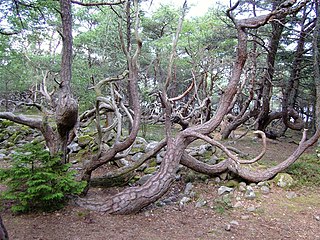
Trollskogen is a windswept, grazed pine forest and nature reserve in the northeast corner of the Baltic island Öland, Sweden. The forest is on a promontory with an exposed shingle beach on the eastern side, the side of the Baltic Sea, and a sheltered bay on the western side, of Grankullaviken bay. The 100-hectare (250-acre) reserve, formerly a Domänreservat, is part of the Böda Kronopark. Its southeastern boundary is also the north border of the nature reserve Bödakusten östra.
